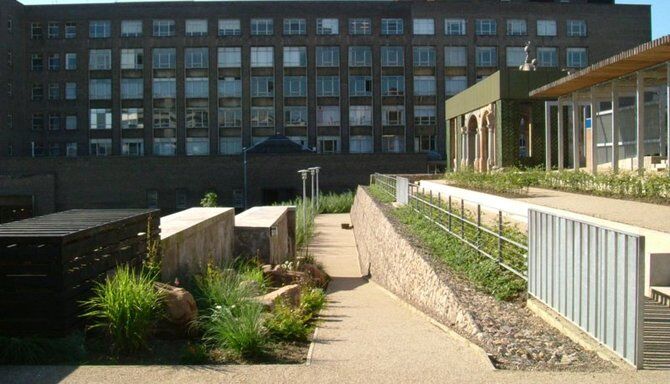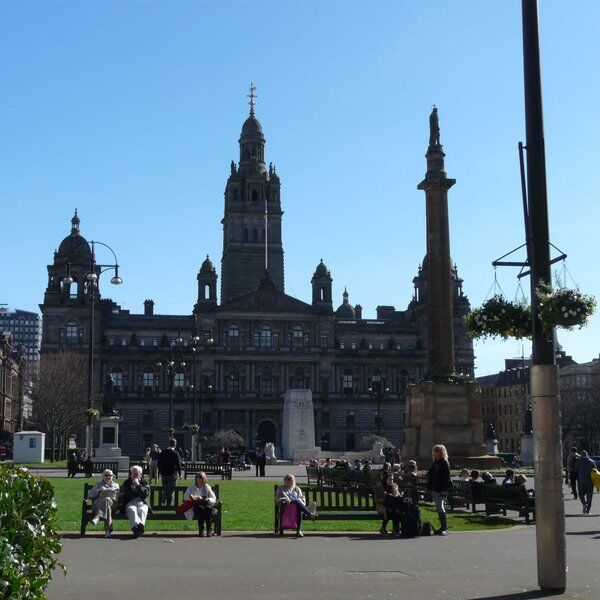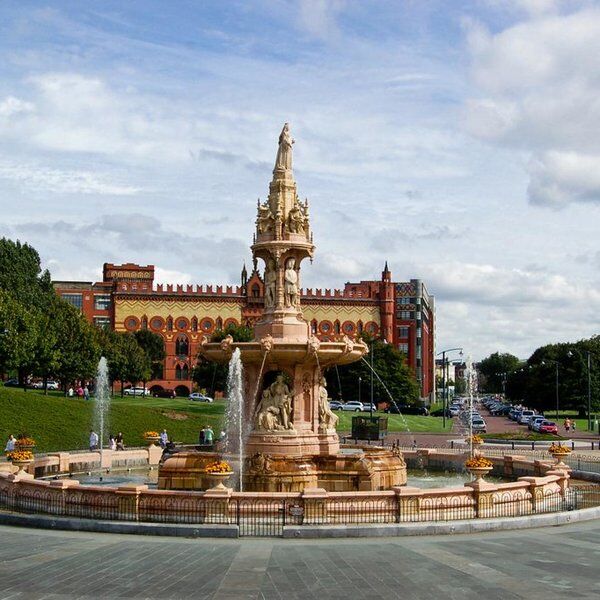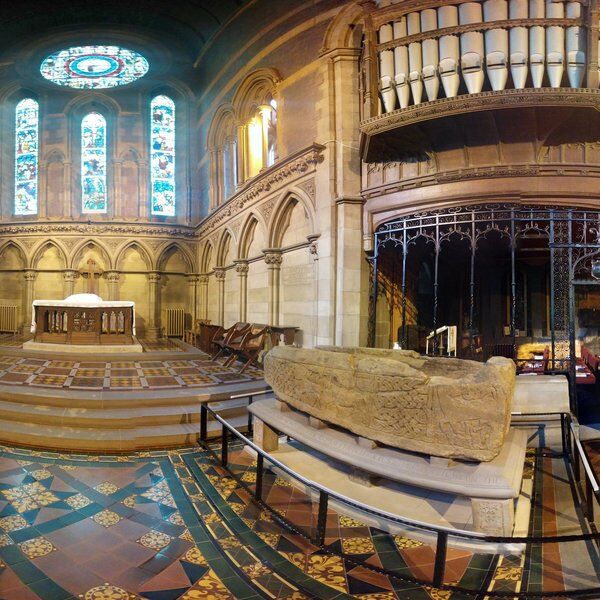From the outside, Rottenrow Gardens appears little more than a quaint, curiously decorated public space. In reality, this green oasis intertwines Glasgow’s unique medical and educational heritage in a way that can be appreciated by all.
Clues to its past are abundant - as long as you know where to look. Read on to find out about Rottenrow Gardens and its role in Glasgow’s unique history!
History of Rottenrow Gardens
From a bird’s eye view, Rottenrow Gardens appears to be a missing, vibrant green puzzle piece from the otherwise sprawling urban pattern that surrounds it. And in some ways, that’s sort of what it is.
Rottenrow Gardens is one of Glasgow’s most recently built public parks and it stands as a kind of memorial to the city’s history, as well as offering the students, staff and public a serene space to enjoy nature near Strathclyde University.
Read on to find out more about the history of Rottenrow Gardens.
Glasgow Lying-in Hospital and Dispensary
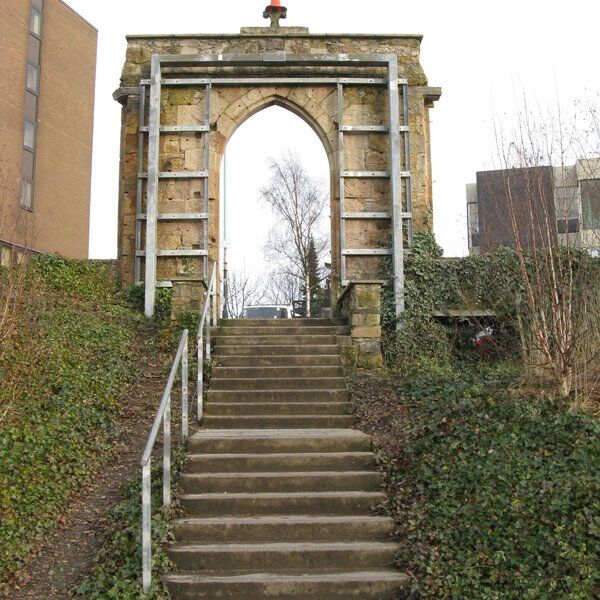
Today, we take it for granted that most people are born in hospitals in the UK. But that wasn’t always the way - even up until the mid 20th century, many more babies were born at home than in hospitals.
That said, it may surprise you to learn that maternity hospitals have existed in the UK since the 18th century. In London, the first “lying-in” hospitals (as maternity hospitals were then known) had been established as early as 1749 and in Edinburgh in 1793. The first maternity hospital in Glasgow opened slightly later in 1834.
Then situated in Greyfriars Wynd, the opening of “Glasgow Lying-In Hospital and Dispensary” was an extraordinary step forward for many women. Firstly, the hospital cared for married and unmarried women alike - a controversial decision that ruffled many feathers, both in the media and among the public.
Secondly, it was a voluntary hospital which depended on charitable donations to pay for the building, staff and maintenance costs.
Lying-in hospitals, as the name suggests, cared for women before and after their births, the time where women are most likely to develop puerperal fever (or, simply put, a uterine infection). Lying-in hospitals didn’t exactly prevent women from getting infected, but they did offer help to women who experienced symptoms following childbirth.
That a lying-in hospital came to Glasgow was thanks to Dr James Wilson, a lecturer in midwifery with a vision to help poor, homeless or destitute women - something Glasgow sadly had a ready supply of. Demand for the hospital’s services quickly rose, and in 1841, Dr Wilson moved his practice to St Andrew’s Square.
The maternity hospital became a family business when, in 1853, Dr Wilson’s son, Dr James George Wilson, earned a degree in Medicine at Glasgow University. Father and son worked at the maternity hospital until Dr Wilson Sr’s death in 1857. In 1860, Dr Wilson Jr moved the premises to Rottenrow where our story of Rottenrow Gardens really begins…
Rottenrow Maternity Hospital

Despite the new premises at Rottenrow, “Glasgow Maternity Hospital” (the lying-in hospital was renamed in 1866) quickly outgrew its new home.
The hospital simply couldn’t keep up with Glasgow’s ever-growing population and destitute women. For a mere two decades, from 1860 until 1881, Glasgow Maternity Hospital operated in an almost constant state of overcapacity, unable to help all the women and babies who required help.
Newspaper headlines appeared in Scottish newspapers such as the Edinburgh Evening News, re-telling horrific stories of women who had been turned away from Glasgow Maternity Hospital.
One such woman, a twenty-four-year-old called Jessie Miller, walked to the hospital near the end of January in 1879 after going into labour. Unfortunately, she arrived at a full hospital and was turned away, despite the obvious need for assistance. Jessie’s stepfather, who had accompanied her, half carried her back to their home on Richard Street. Before reaching their destination, Jessie gave birth to a baby girl on the streets. Twenty minutes after arriving back at the house, she gave birth again, this time to a boy. The newspapers reported that Jessie’s mother was disabled, her stepfather had been out of work and the whole house didn’t contain a blanket. According to one report, Jessie suffered from puerperal fever which left her unconscious for several days and experienced “violent convulsion fits”.
Jessie’s story was a nationwide scandal - but sadly, she wasn’t alone. Accordingly, in 1880, the hospital was left with choice but to start again. The Rottenrow hospital was demolished and in its stead, new premises of new and purpose built buildings were erected. The new Rottenrow Maternity Hospital opened its doors on Tuesday the 11th January in 1881.
In 1914, at the outbreak of the Second World War, the hospital changed its name again: this time to the more regal sounding “Glasgow Royal Maternity and Women’s Hospital”. Rottenrow Hospital was acquired by the Scottish National Health Service (NHS) in 1948, following the formation of the Scottish NHS on the 5th of July that year.
The hospital continued to operate under the management of the NHS until 2001, when it moved to the Glasgow Royal Infirmary. The historic hospital was demolished in 2002, and in its stead, Rottenrow Gardens were established in 2002.
Rottenrow Gardens: The Meaning Behind The Safety Pin
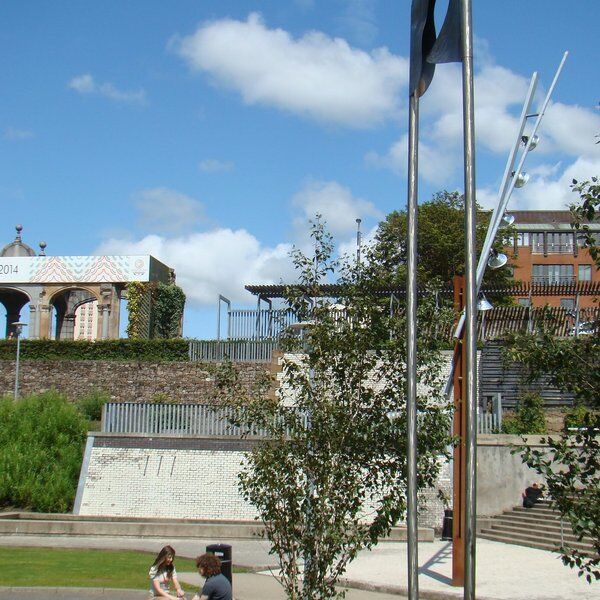
Visitors to Rottenrow Gardens today will notice a giant safety pin sculpture in the gardens. The reason for it being there becomes very clear after a glimpse into the Gardens’ history - and with a little inside information, it quickly becomes one of the most fascinating modern monuments in Scotland.
The sculpture’s official name is “Mhtothta” (meaning ‘maternity’ in Greek), but is locally referred to as the “Monument to Maternity”. It stands at 7 metres (almost 23 feet) in height, and is made from stainless steel.
Designed in 1996 by a local Glasgow artist, George Willie, the sculpture originally bore the name “Just in Case”. The sculpture travelled the length of the UK, first to Portsmouth, later to Edinburgh before finally returning to Glasgow where it was permanently installed in Rottenrow Gardens in 2004.
And just in case you’re unsure what a safety pin has to do with maternity - traditionally, nappies (or diapers, depending on where you’re from) were held together with safety pins.
Bonus Fact about Rottenrow Gardens
Did you know that in 1996 free smoke alarms were given to new mothers at Rottenrow Hospital? It was part of an initiative during National Fire Safety Week headed by Strathclyde fire brigade to help reduce fatalities related to domestic fires.
Discover More about Glasgow with CityDays
Ready to discover more of what Glasgow has to offer?
CityDays have a brand new treasure and scavenger hunt in Glasgow which combines the fun of an escape room with the historic facts and whimsical trivia of a walking tour!
Take the stress out of planning your visit to Glasgow and book your adventure today!
Not visiting Melbourne this time? Don’t worry, you’ll find us all over the world.
